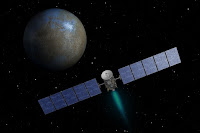Top Los Alamos science stories of 2016
From discoveries on Mars to breakthroughs in cancer research, from national security science to materials science, 2016 has proven to be another productive year for Los Alamos National Laboratory achievements.
‘This year’s significant advancements in high-performance computing, materials science, cancer research as well as national security, space exploration and nuclear nonproliferation science underscore the Lab’s unique multidisciplinary scientific capabilities,’ said Alan Bishop.
An illustration of the space probe dawn arriving at the dwarf planet Ceres. (NASA)
Robotic explorers have found signs of long-lost water on Mars and extensive ice still present on the dwarf planet Ceres — evidence that water truly is almost everywhere we look.
The results were announced last week at the fall meeting of the American Geophysical Union — the world's largest gathering of Earth and space scientists. There, NASA scientists discussed the results from several of the dozen space probes currently exploring the universe beyond our planet.
While scientists are working hard to reach Mars, others are trying to discover whether something beat us there already.
Researchers have long known that Mars is barren and uninhabited, but the question as to whether life ever exited in the planet's past is still up for debate.
This rendering shows NASA’s DART spacecraft serving as a “kinetic impactor” in an effort to change the orbit of the “moonlet” that revolves around the bigger Dydimos asteroid. (ESA Photo)
Cathy Plesko, a researcher at Los Alamos National Laboratory, just wants us to be ready.
She’s a computational geophysicist whose computer models are intended to help figure out how to avoid the potential apocalypse of big comets or asteroids striking the Earth.
“It’s one of those things, like I keep a fire extinguisher in my kitchen,” Plesko says, “not because I expect to have a kitchen fire, but just in case, because sometimes kitchen fires happen.”
Right now, apparently, Earth has no extinguisher for asteroids.
Evaluating Reaction Of A Giant Asteroid Making A Splash Into The Sea
What could possibly occur when a huge asteroid strikes the sea?
Scientists at Los Alamos National Laboratory wanted to evaluate what could possibly occur when a huge asteroid strikes the sea. They found the results to be extremely fascinating. The study was presented at the American Geophysical Union meeting.
The study spearheaded by Galen Gisler and team from ANL employed supercomputers to gauge the impact of a speeding space rock hitting the ocean.
Scanning electron micrograph of a murine macrophage infected with Francisella tularensis strain LVS.
The virulent pathogen that causes the disease tularemia, or "rabbit fever," was weaponized during past world wars and is considered a potential bioweapon. Through a new study of the coccobacillus Francisella, Los Alamos National Laboratory researchers are working to use DNA markers to discern related but relatively harmless species as they are identified and to provide a means to distinguish them from the harmful F. tularensis.
"This large study is particularly notable for having used 31 publicly available genomes plus select genes from about 90 additional isolates," said corresponding author Cheryl Kuske of the Bioenergy & Biome Sciences group at Los Alamos National Laboratory. The paper was published in the current issue of Applied and Environmental Microbiology (AEM).
On the Greenland Ice Sheet, the ice flow more than doubles in speed in many regions during summer, as surface melt drains to the bed and lubricates the motion.
Surface meltwater that drains to the bed of the Greenland Ice Sheet each summer causes changes in ice flow that cannot be fully explained by prevailing theories. Now a multinational, multidisciplinary team led by ice sheet modelers at Los Alamos National Laboratory is exploring how changes in extensive, sediment-choked subglacial "swamps" actually explain why the ice sheet's movement slows down in late summer and winter.
"The drainage system beneath the Greenland Ice Sheet controls how fast the ice flows towards the sea and ultimately contributes to sea-level change," said Matthew Hoffman, lead author on the project and an ice-sheet modeler at Los Alamos. "For more than a decade it's been known that the ice flow more than doubles in speed in many regions during summer, as surface melt drains to the bed and lubricates the motion. This acceleration sends ice to the sea faster. However, the motion also slows down in late summer, fall, and winter, which largely offsets the summer speedup. Exactly why it slows down as much as it does and for as long as it does has not been clear.










